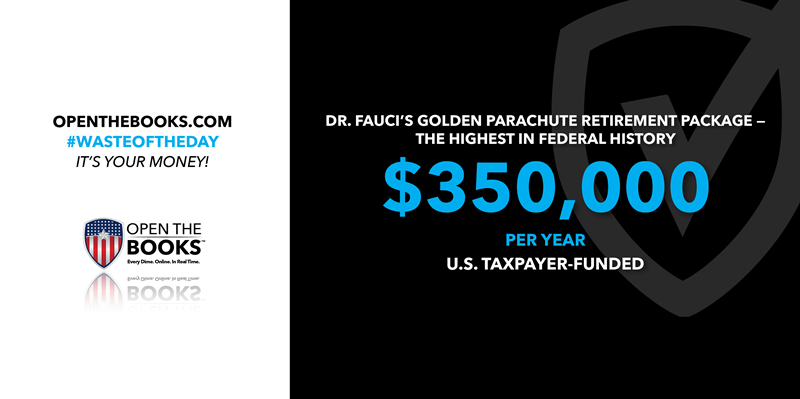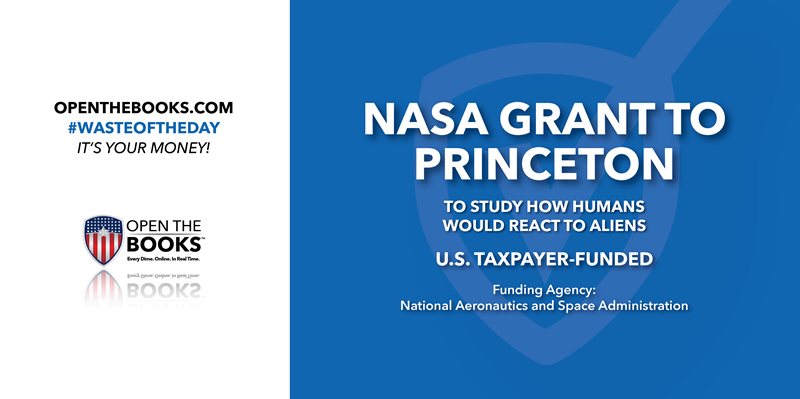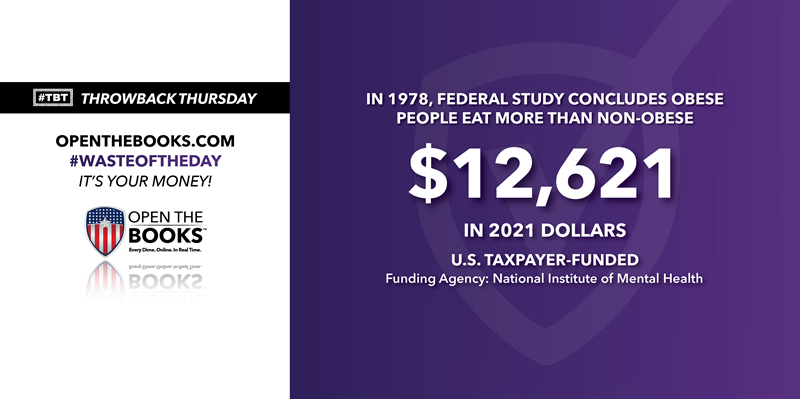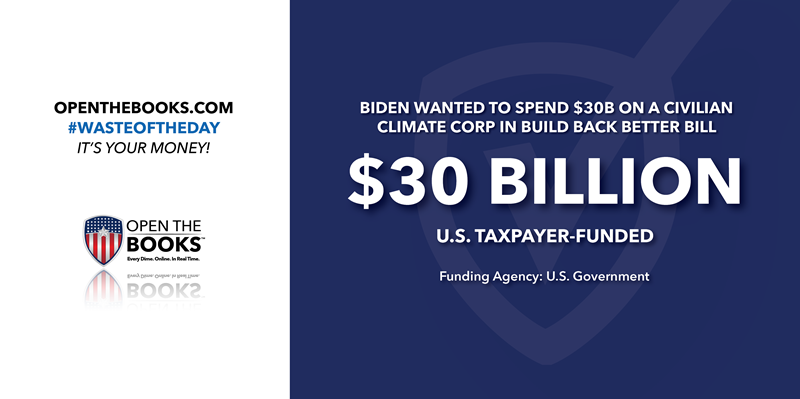
Dr. Fauci’s Retirement Package Will Cost Taxpayers Over $350,000 Per Year – Highest in Federal History
January 17, 2022

When Dr. Fauci decides to retire, his federal pension and post-employment benefits will cost taxpayers over $350,000 each year. Dr. Fauci is already the highest paid federal employee, and soon his retirement package will exceed most working Americans’ salaries.
Federal employees with Fauci’s length of service can retire to earn “80 percent of [their] high-3 average salary, plus credit for [their] sick leave,” according to the U.S. Office of Personnel Management. The last three published years of his salary — 2018: $399,625; 2019: $417,608; and 2020: $434,312 —can be used calculate his potential retirement earnings.
If he’d left federal service at the end of FY2020, figuring 80% of his highest three-year average, would mean a federal pension of $333,745 a year, plus cost-of-living increases (($1,251,545/3) x 80% = $333,745). However, Fauci’s unpublished current salary is at least what it was in 2020. Therefore, his retirement pay would be closer to $347,500 a year. (($1,302,936/3) x 80%).
Additionally, Dr. Fauci is likely eligible for an annuity, paid out by the federal government. After serving 10 years, federal employees are eligible for “2 percent of [their] high-3 average salary for each year.” Dr. Fauci has surpassed the 10-year-minimum work requirement, and if he retired last year he could have added an extra $8,344 a year (($1,251,545/3) x 2% = $8,344). If he leaves at the end of this month, that figure is likely closer to $8,575 a year in annuity payments, assuming his salary did not go down in 2021.
All this adds up to over $350,000 in total yearly compensation starting at nearly $1,000 per day and over $1 million during his first three-years of retirement.
Westfield, New Jersey Spent $18,000 in Covid Aid on Never-Distributed Promotional Tote Bags, Business “Ambassadors”
January 18, 2022

Instead of using federal CARES Act relief money for its intended purpose to help small businesses weather the pandemic, the town of Westfield, New Jersey decided to spend $8,000 on 2,000 promotional tote bags to encourage residents to shop and buy local.
Spending $4 per canvas tote bag to encourage shoppers to shop local might be a laudable idea, but they were never even distributed. U.S. Sen. Joni Ernst (R-Iowa) highlighted the tote bags in her December 2021 “Holiday Grift List."
The tote bags, which read “Love Local, Shop Westfield,” sat in their original boxes through the holidays in a municipal warehouse. They were supposed to be given out by paid ambassadors during the 2020 Christmas holidays at a federally-funded “Holiday Visitors Center,” according to the New Jersey Globe. Then, town officials said that these bags would instead be given out throughout the 2021 year at various events. However, the grant application stated the funds were to be used in 2020.
Westfield also used its CARES Act money to hire consultants to create a retail strategy, and spent $10,000 on ambassadors, “to patrol our downtown streets starting in mid-November and continuing every day through Christmas.” They handed out masks and maps (though not in tote bags). Back at the federally-funded Holiday Visitors Center, visitors could get free giftwrapping and local delivery on their new purchases.
This may seem like a decent way to promote small businesses. Yet other cities spent their money directly on small businesses: purchasing heaters for outdoor dining at restaurants, giving grants to help businesses stay open, and purchasing personal protective equipment for retailors.
While the tote bags take up space in a warehouse, taxpayers may wonder why the funds were ever allocated in the first place.
Princeton Receives NASA Grant to Study How Humans Would React to Aliens
January 19, 2022

Many of us have pondered how we would react to the discovery of extraterrestrial life. Leave it to NASA to spend taxpayer money on that question, though. According to the New York Post, NASA awarded a grant to the Center for Theological Inquiry at Princeton University to hire 24 theologians to determine what impact the discovery of alien life would have on religious populations.
Dr. Rev. Andrew Davison, one of the theologians for this project, has worked at the Center since 2016 and wrote on his blog regarding his research:
“The most significant question there is probably whether one would respond theologically to the prospect of life elsewhere in terms of there having been many incarnations, or only the one theologians talk about in Jesus. I have also been thinking about the doctrine of creation, especially in terms of how it deals with themes of multiplicity and diversity.”
While the exact amount of funding for this project is unclear, we do know that NASA has funded similar projects in the past. In 2014, NASA gave the Center for Theological Inquiry $1.1 million to study worshippers’ interest in and openness to scientific inquiry in a study called the Societal Implications of Astrobiology.
Princeton University currently holds an endowment of $37.7 billion, and charges students a tuition of $57,690 per year.
Clearly, Princeton could have funded this research themselves. So why are they using taxpayer dollars?
Throwback Thursday—In 1978, Federal Study Concludes Obese People Eat More Than Non-Obese
January 20, 2022

Throwback Thursday!
A “groundbreaking study” in 1978 found that obese people ate more food than non-obese people. For its “obvious conclusions,” Sen. William Proxmire (D-Wisc.) from Wisconsin, gave the National Institute of Mental Health a Golden Fleece award for wasteful and nonsensical spending in June 1978.
The study compared the amount of food obese and non-obese people ate in restaurants where they had a choice between ordering from a menu and going to a buffet.
Unsurprisingly, researchers found that far more food was eaten at the buffet than from the menu. “This was a pedestrian study with all the trappings of research, which reached amazingly obvious conclusions,” Proxmire said then.
About 1,718 patrons were observed in four restaurants of different ethnic origin — Italian, Irish, American, and Danish — where one could either order from a menu or visit a buffet. The customers were rated as obese or non-obese by two observers who had been trained on silhouettes and to recognize people who were about 30 percent or more over desirable weight.
The researchers found that obese people made up a far higher percentage of the customers in restaurants when a buffet was offered than those with traditional menu service. While the exact cost couldn’t be calculated, the researcher estimated it at a few hundred dollars. Proxmire noted that the researcher had a very good reputation in his field, collected no salary, and had generally worked for relatively modest amounts compared with the professional grant-getters.
But in the end, Proxmire’s staff estimated the study cost $2,500 to $3,000 — at most $12,621 in 2021 dollars. That may not sound like much relative to how much the government usually spends, but it is $12,000 more than was necessary arrive at the conclusions that the study did.
Biden Wanted to Spend $30 Billion on a Civilian Climate Corp in Build Back Better
January 21, 2022

On January 27, 2021, President Biden signed an Executive Order (EO) to combat climate change. The EO officially began research into the creation of a Civilian Climate Corps.
The Corps “shall aim to conserve and restore public lands and waters, bolster community resilience, increase reforestation, increase carbon sequestration in the agricultural sector, protect biodiversity, improve access to recreation, and address the changing climate.”
In 1933, Franklin D Roosevelt created a similar program called the Civilian Conservation Corps. They cut trails, built roads, and solidified infrastructure, and had about 500,000 annual members at its height.
The CCC lasted until 1942, built 100,000 miles of roads and trails, 318,000 dams, and tens of thousands of bridges, and employed over 3 million citizens over its lifetime. Since then, there have been various smaller decentralized programs like the Corps Network and AmeriCorps, all which received some federal funding, but nothing at the scale of the CCC. President Obama tried to expand AmeriCorps to 100,000 members, but ultimately failed, and its membership was about 75,000.
In Biden’s Build Back Better proposal, he calls for hiring 300,000 Americans at a cost of anywhere from $10 to $30 billion for his Climate Corps, at a cost of between $40,000 to $70,000 per member. That’s low for some Congressional Democrats. Sen. Ed Markey and Congresswoman Alexandria Ocasio Cortez have introduced the Civilian Climate Corps for Jobs and Justice Act, asking for $132 billion for a corps of 1.5 million members.
The CCC is currently in Biden’s Build Back Better proposal that passed the House of Representatives on November 19, 2021, and includes about $7 billion for staffing the CCC. The bill stalled in the Senate after Sen. Joe Manchin announced he wouldn’t vote for it, but Senate Majority Leader Chuck Schumer has vowed to call a vote on it again.
The #WasteOfTheDay is presented by the forensic auditors at OpenTheBooks.com.